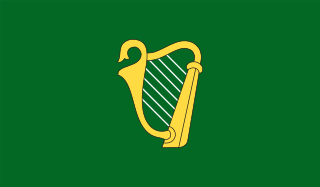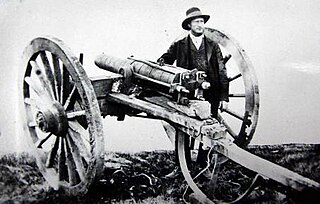
The South African Republic, also known as the Transvaal Republic, was an independent Boer republic in Southern Africa which existed from 1852 to 1902, when it was annexed into the British Empire as a result of the Second Boer War.

The Second Boer War, also known as the Boer War, Transvaal War, Anglo–Boer War, or South African War, was a conflict fought between the British Empire and the two Boer republics over the Empire's influence in Southern Africa.

The First Boer War, was fought from 16 December 1880 until 23 March 1881 between the United Kingdom and Boers of the Transvaal. The war resulted in a Boer victory and eventual independence of the South African Republic. The war is also known as the First Anglo–Boer War, the Transvaal War or the Transvaal Rebellion.

The Battle of Majuba Hill on 27 February 1881 was the final and decisive battle of the First Boer War that was a resounding victory for the Boers. The British Major General Sir George Pomeroy Colley occupied the summit of the hill on the night of 26–27 February 1881. Colley's motive for occupying Majuba Hill, near Volksrust, now in South Africa, may have been anxiety that the Boers would soon occupy it themselves, since he had witnessed their trenches being dug in the direction of the hill.

The siege of Mafeking was a 217-day siege battle for the town of Mafeking in South Africa during the Second Boer War from October 1899 to May 1900. The siege received considerable attention as Lord Edward Cecil, the son of the British prime minister, was in the besieged town, as also was Lady Sarah Wilson, a daughter of the Duke of Marlborough and aunt of Winston Churchill. The siege turned the British commander, Colonel Robert Baden-Powell, into a national hero. The Relief of Mafeking, while of little military significance, was a morale boost for the struggling British.

The battle of Bronkhorstspruit was the first major engagement of the First Boer War. It took place by the Bronkhorstspruit river, near the town of Bronkhorstspruit, Transvaal, on 20 December 1880. Threatened by the growing numbers of militant Boers in the Pretoria region, the British recalled the 94th Regiment of Foot, which had several companies garrisoned in towns and villages across the wider area. The regiment's commanding officer, Lieutenant Colonel Philip Robert Anstruther, led a 34-wagon column consisting of roughly 250 men on a 188-mile (303 km) journey from Lydenburg back to Pretoria. A similar-sized Boer commando force, led by Francois Gerhardus Joubert, was ordered to intercept and stop the British.

The Battle of Laing's Nek was a major battle fought at Laing's Nek during the First Boer War on 28 January 1881.

Two Irish Commandos, volunteer military units of guerrilla militia, fought alongside the Boers against the British forces during the Second Boer War (1899–1902).
Jan Christiaan Smuts, OM was a prominent South African and Commonwealth statesman and military leader. He served as a Boer general during the Boer War, a British general during the First World War and was appointed field marshal during the Second World War. In addition to various cabinet appointments, he served as prime minister of the Union of South Africa from 1919 to 1924 and from 1939 to 1948. He played a leading part in the post war settlements at the end of both world wars, making significant contributions towards the creation of both the League of Nations and the United Nations.

The Battle of Magersfontein was fought on 11 December 1899, at Magersfontein, near Kimberley, South Africa, on the borders of the Cape Colony and the independent republic of the Orange Free State. British forces under Lieutenant General Lord Methuen were advancing north along the railway line from the Cape to relieve the siege of Kimberley, but their path was blocked at Magersfontein by a Boer force that was entrenched in the surrounding hills. The British had already fought a series of battles with the Boers, most recently at Modder River, where the advance was temporarily halted.

The South African Constabulary (SAC) was a paramilitary force set up in 1900 under British Army control to police areas captured from the two independent Boer republics of Transvaal and Orange Free State during the Second Boer War. Its first Inspector-General was Major-General Robert Baden-Powell, later the founder of the worldwide Scout Movement. After hostilities ended in 1902, the two countries became British colonies and the force was disbanded in 1908.

The Boer Commandos or "Kommandos" were volunteer military units of guerilla militia organized by the Boer people of South Africa. From this came the term "commando" into the English language during the Second Boer War of 1899–1902 as per Costica Andrew.

The military history of Australia during the Boer War is complex, and includes a period of history in which the six formerly autonomous British Australian colonies federated to become the Commonwealth of Australia. At the outbreak of the Second Boer War, each of these separate colonies maintained their own, independent military forces, but by the cessation of hostilities, these six armies had come under a centralised command to form the Australian Army.

The 94th Regiment of Foot was a British Army line infantry regiment, raised as the Scotch Brigade in October 1794. It was renumbered as the 94th Regiment of Foot in December 1802 and disbanded in December 1818. The regiment was reformed in December 1823 and served until 1881 when it amalgamated with the 88th Regiment of Foot to form the Connaught Rangers.

Marthinus Nikolaas Ras was a South African farmer, soldier, and gun-maker who is considered the father of South African Artillery.

The Battle of Elands River was an engagement of the Second Boer War that took place between 4 and 16 August 1900 in western Transvaal. The battle was fought at Brakfontein Drift near the Elands River between a force of 2,000 to 3,000 Boers and a garrison of 500 Australian, Rhodesian, Canadian and British soldiers, which was stationed there to protect a British supply dump that had been established along the route between Mafeking and Pretoria. The Boer force, which consisted of several commandos under the overall leadership of Koos de la Rey, was in desperate need of provisions after earlier fighting had cut it off from its support base. As a result, it was decided to attack the garrison along the Elands River in an effort to capture the supplies located there.
The siege of Lydenburg was a siege carried out by South African Republican forces on British-occupied Lydenburg, between January and March 1881 during the First Boer War. Despite fierce British resistance, the Boers reclaimed the town following the British defeat at the end of the war. The siege lasted 84 days.
The siege of Marabastad was a siege of Fort Marabastad, in present day Limpopo, South Africa, carried out by the Boer Republic of Transvaal, starting on 11 January 1881, and ending with British surrender on 2 April 1881. It took place during the First Boer War, during which Boer forces besieged several British garrisons across the country.

General Jacobus Philippus Snyman was one of the dominant military figures in the South African Republic during the 19th century. He was the District Commissioner, Native Commissioner, and Commandant for the Marico district and led the Rustenburg and Marico commandos during the Second Boer War. Nicknamed Hamerkop, Snyman came to international prominence as the military commander at the Siege of Mafeking from November 1899 to May 1900.
The Battle of Middelfontein was a Boer War battle fought from 22 to 25 January 1901, near Rustenburg in the Northern Transvaal region. A column of British forces under General Cunningham were marching to Vlakfontein to cut off Boer forces under De la Rey when they were attacked by commandos near Middelfontein farm.















